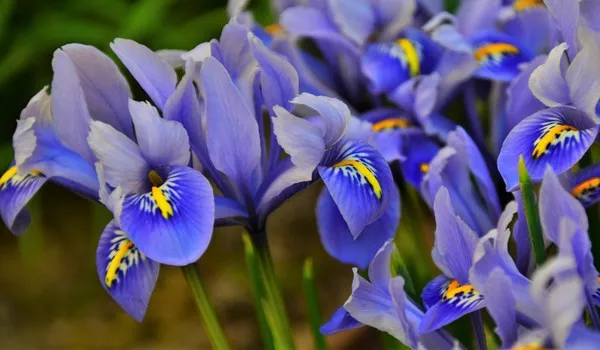Iris flowers are beloved for their stunning blooms and diverse colors, making them a favorite among gardeners worldwide. With their elegant petals and distinct shapes, irises can add a touch of sophistication to any garden or landscape. Whether you’re a seasoned gardener or a novice, growing iris flowers can be a rewarding and fulfilling experience. In this comprehensive guide, we’ll explore everything you need to know to successfully cultivate these gorgeous plants.
Understanding Iris Flowers
Before diving into the details of growing iris flowers, it’s essential to understand the basics of these plants. Iris is a genus of flowering plants that belongs to the Iridaceae family, which comprises over 200 species. These plants are renowned for their showy flowers, which come in a wide range of colors, including shades of purple, blue, white, yellow, and even black.
There are several popular varieties of iris, each with its unique characteristics and growing requirements. Bearded irises, with their distinctive fuzzy “beards” on the lower petals, are perhaps the most well-known type. Other common varieties include Siberian irises, Japanese irises, and Louisiana irises, each with its own growth habits and flower forms.
Choosing the Right Location
The first step in growing healthy iris flowers is selecting an appropriate location for planting. Irises thrive in well-drained soil and prefer full sun, although some varieties can tolerate partial shade. When choosing a spot for your irises, ensure that the soil is fertile and loamy, with good drainage to prevent waterlogging.
Before planting, it’s a good idea to test the soil pH to ensure it falls within the optimal range for irises, which is typically between 6.0 and 7.0. If necessary, you can amend the soil with organic matter, such as compost or aged manure, to improve its texture and fertility.
Planting Iris Bulbs
Iris flowers can be grown from bulbs, rhizomes, or seeds, depending on the variety. Bulbs are the most common method of propagation and are typically planted in late summer or early fall, allowing them to establish roots before the onset of winter.
To plant iris bulbs, follow these steps:
1. Prepare the soil by loosening it to a depth of 8-10 inches and removing any weeds or debris.
2. Dig a shallow hole approximately 4-6 inches deep, making sure it is wide enough to accommodate the bulb without crowding.
3. Place the bulb in the hole with the pointed end facing upward, and cover it with soil, gently firming it down to remove air pockets.
4. Space the bulbs approximately 12-24 inches apart to allow for proper airflow and prevent overcrowding as they grow.
Caring for Iris Flowers
Once planted, iris flowers require minimal maintenance but benefit from regular care to ensure optimal growth and blooming. Here are some essential care tips for growing healthy iris flowers:
1. Watering: Irises prefer moderate moisture levels and should be watered regularly, especially during periods of drought. However, it’s essential to avoid overwatering, as soggy soil can lead to root rot and other problems. Water deeply but infrequently, allowing the soil to dry out slightly between waterings.
2. Fertilizing: Irises are light feeders and typically don’t require much fertilizer. Apply a balanced, slow-release fertilizer in early spring before the plants start actively growing. Avoid high-nitrogen fertilizers, as they can promote excessive foliage growth at the expense of flowering.
3. Mulching: Applying a layer of mulch around iris plants can help conserve soil moisture, suppress weeds, and regulate soil temperature. Use organic mulches such as shredded bark, straw, or compost, and apply a 2-3 inch layer around the base of the plants, taking care not to cover the rhizomes.
4. Dividing: Over time, iris clumps can become overcrowded, leading to reduced blooming and overall plant health. Dividing the rhizomes every 3-4 years helps rejuvenate the plants and maintain vigor. Wait until after flowering has finished, then carefully dig up the clump and separate the individual rhizomes, discarding any old or diseased sections. Replant the divisions in prepared soil, spacing them apart as recommended.
5. Pest and Disease Control: While irises are relatively resistant to pests and diseases, they can occasionally be affected by issues such as iris borers, aphids, and fungal diseases like leaf spot or root rot. Inspect plants regularly for signs of pests or disease, and take appropriate measures to control infestations, such as removing affected foliage or applying organic insecticides or fungicides as needed.
By following these care guidelines, you can enjoy healthy, vibrant iris flowers year after year, adding beauty and elegance to your garden landscape.
Conclusion
Growing iris flowers is a rewarding endeavor that allows you to enjoy the beauty of these stunning plants up close. By understanding their basic requirements and following proper planting and care practices, you can cultivate healthy, thriving irises that will delight you with their colorful blooms season after season. Whether you’re a seasoned gardener or a novice enthusiast, incorporating iris flowers into your landscape is sure to enhance its beauty and charm. So roll up your sleeves, dig in the dirt, and watch as your iris garden blossoms into a masterpiece of natural elegance.


